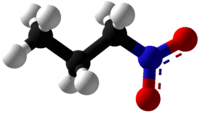1-Nitropropane
 | |
 | |
| Names | |
|---|---|
| IUPAC name
1-Nitropropane | |
| Identifiers | |
| 108-03-2 | |
| 3D model (Jmol) | Interactive image |
| Abbreviations | 1-NP |
| ChEBI | CHEBI:76261 |
| ChemSpider | 7615 |
| ECHA InfoCard | 100.003.223 |
| EC Number | 203-544-9 |
| MeSH | C035314 |
| PubChem | 7903 |
| |
| |
| Properties | |
| C3H7NO2 | |
| Molar mass | 89.09 g·mol−1 |
| Appearance | Colorless liquid[1] |
| Odor | Disagreeable[2] |
| Density | 0.998 g/cm3 |
| Melting point | −108 °C (−162 °F; 165 K) |
| Boiling point | 132 °C (270 °F; 405 K) |
| 1.4 mg/L | |
| Solubility | soluble in chloroform |
| Vapor pressure | 8 mmHg (20°C)[2] |
| Acidity (pKa) | 17.0 [3] |
| Viscosity | 0.844 cP |
| Hazards | |
| NFPA 704 | |
| Flash point | 35 °C (95 °F; 308 K) |
| 420 °C (788 °F; 693 K) | |
| Explosive limits | 2.6-11.0% |
| Lethal dose or concentration (LD, LC): | |
| LD50 (median dose) |
800 mg/kg (mouse, oral) 455 mg/kg (rat, oral)[4] |
| LDLo (lowest published) |
250 mg/kg (rabbit, oral)[4] |
| LC50 (median concentration) |
3100 ppm (rat, 8 hr)[4] |
| US health exposure limits (NIOSH): | |
| PEL (Permissible) |
TWA 25 ppm (90 mg/m3)[2] |
| REL (Recommended) |
TWA 25 ppm (90 mg/m3)[2] |
| IDLH (Immediate danger) |
1000 ppm[2] |
| Except where otherwise noted, data are given for materials in their standard state (at 25 °C [77 °F], 100 kPa). | |
| Infobox references | |
1-Nitropropane (1-NP) is a solvent. It is a colorless liquid, an isomer of 2-nitropropane (2-NP), and classified as a nitro compound.
Preparation
1-NP is produced industrially by the reaction of propane and nitric acid. This reaction forms four nitroalkanes: nitromethane, nitroethane, 1-Nitropropane, and 2-Nitropropane. 1-NP is also a byproduct of the process for making 2-NP, which is done by vapour phase nitration of propane.
Uses
Most 1-nitropropane is used as a starting material for other compounds. The other uses are solvent-based paints, solvent-based inks and adhesives, and as a solvent for chemical reactions.[5]
Safety
1-NP is toxic to humans and can cause damage to the kidneys and liver. The vapours are irritating for the lungs and eyes and the maximum exposure rate is 25 ppm.[6] It is not known to be a carcinogen.
Reactions
1-NP decomposes under the influence of heat into toxic gases. It also reacts violently with oxidizing agents and strong bases.[7]
References
- ↑ - MDMS sheets
- 1 2 3 4 5 "NIOSH Pocket Guide to Chemical Hazards #0459". National Institute for Occupational Safety and Health (NIOSH).
- ↑ Reich, Hans. "Bordwell pKa table: "Nitroalkanes"". University of Wisconsin Chemistry Department. Retrieved 17 January 2016.
- 1 2 3 "1-Nitropropane". Immediately Dangerous to Life and Health. National Institute for Occupational Safety and Health (NIOSH).
- ↑ - information sheet
- ↑ - MDMS sheets
- ↑ - Dutch Wikipedia
